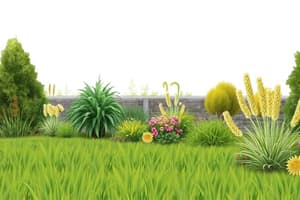Podcast
Questions and Answers
What is the recommended spacing for plugs when repairing bare areas of a lawn?
What is the recommended spacing for plugs when repairing bare areas of a lawn?
- 1 to 2 inches apart
- 12 to 18 inches apart
- 6 to 12 inches apart (correct)
- 3 to 5 inches apart
Which mowing practice is recommended to maintain a healthy lawn?
Which mowing practice is recommended to maintain a healthy lawn?
- Use a dull blade for a rough cut
- Remove up to 50% of the grass blade length
- Mow only once a month
- Never remove more than 1/3 of the grass blade (correct)
What is the ideal mowing height for Common Bermudagrass?
What is the ideal mowing height for Common Bermudagrass?
- 1½ to 2 inches
- ½ to 1 inch
- ¾ to 1¼ inches (correct)
- 1 to 1½ inches
Which of the following practices enhances the health and density of a lawn?
Which of the following practices enhances the health and density of a lawn?
Which type of grass requires a mowing height of 3 to 4 inches?
Which type of grass requires a mowing height of 3 to 4 inches?
What is the best season to repair your lawn for optimal results?
What is the best season to repair your lawn for optimal results?
What is a primary benefit of sodding in lawn repair?
What is a primary benefit of sodding in lawn repair?
How long should you water newly seeded grass daily after overseeding?
How long should you water newly seeded grass daily after overseeding?
What does core aeration primarily help improve in a lawn?
What does core aeration primarily help improve in a lawn?
Why is proper fertilization critical after seeding?
Why is proper fertilization critical after seeding?
What is the primary purpose of watering newly laid sod?
What is the primary purpose of watering newly laid sod?
Which method involves planting small patches of grass taken from healthy areas of the lawn?
Which method involves planting small patches of grass taken from healthy areas of the lawn?
What environmental condition helps newly planted grass best during the repair process?
What environmental condition helps newly planted grass best during the repair process?
Flashcards
Plugging
Plugging
Planting small plugs of healthy grass from your lawn into bare spots to fill them in.
Preparing the Soil
Preparing the Soil
Using a rake to remove debris and loosen the top layer of soil before seeding.
Watering the Plugs/Seeds
Watering the Plugs/Seeds
Making sure the newly planted grass gets enough water to grow and thrive.
Mowing Height
Mowing Height
Signup and view all the flashcards
Aeration
Aeration
Signup and view all the flashcards
Sodding
Sodding
Signup and view all the flashcards
Ideal Timing for Lawn Repair
Ideal Timing for Lawn Repair
Signup and view all the flashcards
Watering for Lawn Repair
Watering for Lawn Repair
Signup and view all the flashcards
Fertilization for Lawn Repair
Fertilization for Lawn Repair
Signup and view all the flashcards
Core Aeration for Lawn Repair
Core Aeration for Lawn Repair
Signup and view all the flashcards
Thinning or Bare Patches - Introduction
Thinning or Bare Patches - Introduction
Signup and view all the flashcards
Lawn Renovation and Repair
Lawn Renovation and Repair
Signup and view all the flashcards
Study Notes
Lawn Renovation and Repair
- Sodding: Laying down pre-grown grass patches or rolls; instant results for larger bare areas
- Plugging: Planting small grass patches from healthy areas; plugs spaced 6-12 inches apart
- Reseeding: Planting grass seed in bare areas; choose suitable species for region and conditions
- Watering: Daily, 15-20 minutes; important after overseeding to keep the seed moist
- Fertilization: Proper fertilization supports seed growth and development; use slow-release fertilizer
- Core Aeration: Improves soil drainage, reduces diseases, allows water and nutrients to penetrate deeper
- Mowing: Regular mowing with a sharp blade; remove no more than 1/3 of the grass blade at each mowing
Recommended Mowing Height
- Common Bermudagrass: 3/4 to 1 1/2 inches
- Hybrid Bermudagrass: 1/2 to 1 1/2 inches
- Centipedegrass: 1 to 2 inches
- Zoysiagrass: 1 to 2 1/2 inches
- St. Augustine: 3 to 4 inches
- Fescue: 3 to 4 inches
Timing for Lawn Repairs
- Spring or fall are ideal times to repair lawns due to milder temperatures and reduced weed competition
Studying That Suits You
Use AI to generate personalized quizzes and flashcards to suit your learning preferences.




